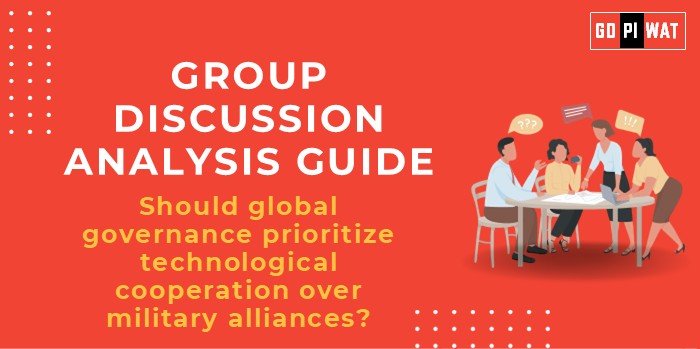📋 Group Discussion Analysis Guide: Should Global Governance Prioritize Technological Cooperation Over Military Alliances?
🌐 Introduction to the Topic
📖 Opening Context
“In an increasingly interconnected world, the choice between prioritizing technological cooperation or military alliances reflects the evolving challenges and opportunities in global governance.”
📜 Topic Background
Traditionally, military alliances have been the cornerstone of international relations, exemplified by NATO and regional pacts. However, in the 21st century, technological cooperation, particularly in AI, cyber-security, and climate tech, has emerged as a pivotal driver of global influence and problem-solving.
📊 Quick Facts and Key Statistics
- 💰 Global Military Spending: $2.24 trillion in 2022 (SIPRI) – indicates the heavy focus on military alliances.
- 🤖 Technological Advancements: AI market projected to reach $1.59 trillion by 2030 – underscores the economic weight of technological cooperation.
- ⚠️ Cybersecurity Threats: Cybercrime damage is projected to cost $10.5 trillion annually by 2025.
- 🌍 Digital Divide: 37% of the world’s population still lacks internet access, highlighting inequality issues.
🤝 Stakeholders and Their Roles
- 🏛️ Governments: Drive policy and international negotiations (e.g., US, China, EU in tech standards).
- 🏢 Private Sector: Innovates and deploys technology solutions globally (e.g., Google, Huawei).
- 🌐 International Organizations: Set frameworks for cooperation (e.g., UN, ITU).
- ⚔️ Military Alliances: Maintain security but risk dominance over tech resources (e.g., NATO’s emerging tech policies).
🏆 Achievements and Challenges
✨ Achievements
- 🌐 Technological Advancements: Global standards for 5G developed collaboratively.
- 🔐 Cybersecurity Pacts: Agreements like the Paris Call for Trust and Security in Cyberspace.
- 💉 Global Health Tech: Success of mRNA technology sharing during the COVID-19 pandemic.
⚠️ Challenges
- 🌍 Fragmented Cooperation: US-China tensions hinder global tech governance.
- ⚔️ Weaponization of Technology: Dual-use technologies blur lines between civilian and military applications.
- 🤝 Trust Deficits: Unequal tech access exacerbates geopolitical tensions.
🌍 Global Comparisons
- ✅ Success: The European Union’s GDPR model is a benchmark in tech cooperation.
- ⚠️ Challenges: Rivalries like the US-China tech war disrupt global tech progress.
📖 Case Studies
- 🤝 Success: India-US collaboration on semiconductors.
- ⚡ Failure: Lack of consensus at COP26 on technology-sharing for renewable energy.
💡 Structured Arguments for Discussion
- 🛠️ Supporting Stance: “Technological cooperation fosters innovation, drives economic growth, and addresses global challenges like climate change and pandemics.”
- 🛡️ Opposing Stance: “Military alliances ensure stability and prevent conflicts, laying the groundwork for technological progress.”
- ⚖️ Balanced Perspective: “Both elements are crucial but should be contextually prioritized to address specific global challenges.”
🎯 Effective Discussion Approaches
🔑 Opening Approaches
- 📊 “As cybercrime becomes the new battlefield, isn’t it time to prioritize technological cooperation over traditional military pacts?”
- 🤖 “Considering that AI could add $15.7 trillion to the global economy, isn’t technological leadership the real geopolitical goal?”
⚙️ Counter-Argument Handling
- 🔄 “Military alliances historically ensured peace, but can they tackle non-traditional threats like climate or cyber risks?”
- 🤝 “Doesn’t focusing on tech also strengthen military innovation, creating a synergistic strategy?”
🧠 Strategic Analysis of Strengths and Weaknesses
SWOT Analysis:
- 💪 Strengths: Drives global problem-solving; economic multiplier; innovation catalyst.
- 🛠️ Weaknesses: Technology monopolization risks; under-regulated AI; digital divides.
- 🌟 Opportunities: Enhanced global leadership; new markets; multilateral solutions.
- ⚠️ Threats: Cyber warfare; lack of trust; economic espionage.
🏫 Connecting with B-School Applications
📚 Real-World Applications
- 🌐 Projects on international tech standards, AI policy analysis, and global supply chains.
🎓 Sample Interview Questions
- ❓ “How can B-schools contribute to global tech governance through partnerships?”
- ❓ “Evaluate the impact of military spending on global innovation.”
💡 Insights for Students
- 📈 Explore the intersection of policy, technology, and business.
- 💻 Understand global market dynamics influenced by tech innovation.


